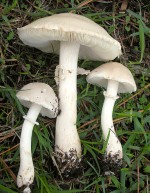 With a world wide distribution including North America, the off-white parasol is found from summer to fall solitary, scattered, or in groups in disturbed areas such as roadsides, fields, meadows, pastures, and lawns, and occasionally in the woods. The mushroom stands two to four inches tall and has a cap 2 to 4.5 inches across. The cap is fleshy, satiny, and white at first may become tinged with red or brown and crack with age. It has a delicate fringed margin and an ovoid shape that flattens and may become depressed . The gills are free, crowded, and white but may become pink when the white spores mature. The stem is white but stains yellow, and is swollen at the base. It is satiny, has a thin ring on its upper third, and is 2.5 to 4inches long and about 1/2 inch in diameter.
With a world wide distribution including North America, the off-white parasol is found from summer to fall solitary, scattered, or in groups in disturbed areas such as roadsides, fields, meadows, pastures, and lawns, and occasionally in the woods. The mushroom stands two to four inches tall and has a cap 2 to 4.5 inches across. The cap is fleshy, satiny, and white at first may become tinged with red or brown and crack with age. It has a delicate fringed margin and an ovoid shape that flattens and may become depressed . The gills are free, crowded, and white but may become pink when the white spores mature. The stem is white but stains yellow, and is swollen at the base. It is satiny, has a thin ring on its upper third, and is 2.5 to 4inches long and about 1/2 inch in diameter.
With its pleasant odor and thick tender flesh, the off-white parasol is considered edible but its strong resemblance to the deadly white amanita (the death cap), make it a poor choice for the table. The taste is not considered outstanding enough to take the chance of eating a deadly mushroom by mistake and so it is generally avoided. Caution is especially needed because some people seem to be considerably intolerant of the mushroom and must avoid it. This is a prime example of the need for expert opinion on a mushroom gathered from the wild before eating it.
Photo Credit: Ronpast Wikipedia